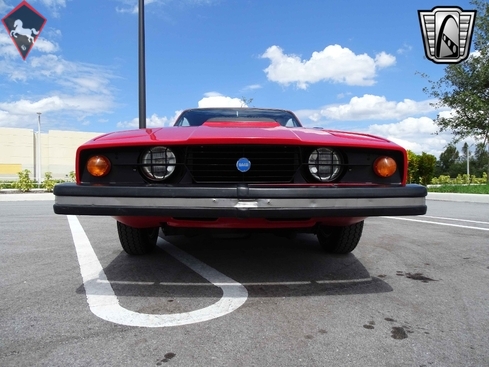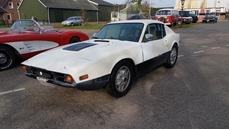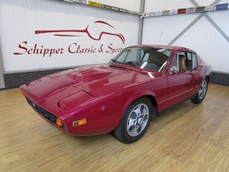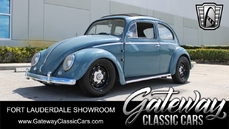Saab 97 Sonett II/III V4--1.7Lit 1973
General description :
Mileage : 15893
Interior Color : Tan
Exterior Color : Red
VIN : 97735002046
Transmission Description : 4-speed Manual
Doors : 2
Description : Gateway Classic Cars of Fort Lauderdale is excited to present this exhilarating 1973 Saab Sonett III in red, with beige and black interior.
The Saab Sonett is a special type of low production classic that remains unheard of amongst the general public, and even some car enthusiasts. At first glance, one might think Opel GT, Pantera, or even Ferrari. The Sonnet is for those who want a unique, quirky, and quick little sports car that is rarely ever spotted on the road. Saab Automobile was a Swedish manufacturer founded in the 1940's. Production of the Sonett I began in 1956, and only 6 were made to be displayed at a Swedish motor show. Production numbers picked up in the 60's with the upgraded Sonett II, and from 1970 to 1974 the Sonnet III was manufactured.
Like vintage Corvettes, the body panels of the Saab are composed of fiberglass. Lightweight, and impossible to rust. The headlights manually pop-up with a lever- pretty quirky. Won't ever have to worry about motors breaking, and your car looking as if its winking at everyone. The rear glass panel can be popped open as a hatch for easy cargo access, and the fuel cap is located on the passenger sail panel.
The Sonett is equipped with a Ford 1.7L V4 engine. Paired with a 4-speed manual transmission. The car is an absolute blast to drive, and the motor sounds great in and out of the cockpit. The exterior is in red with black trim and bumpers, with a clean tan interior. The seats are in great shape! The stereo has been upgraded to a Retrosound radio. Which appears period correct but allows for auxiliary input, so you can play music from your phone.
The Saab Sonett III, a fun and quirky little sports car- a hidden gem.
https://www.gatewayclassiccars.com/vehicle/FTL/1642/1973-Saab-Sonett-III
1973 Saab 97 Sonett II/III V4--1.7Lit is listed sold on ClassicDigest in Coral Springs by Gateway Classic Cars for $27000.
Car Facts
Car type : Car Make : Saab Model : 97 Sonett II/III Model Version : V4--1.7Lit Engine size : 1.7 Model Year : 1973 Location : Ft. Lauderdale
Sold
Seller Information
Sold
People who viewed this Saab 97 Sonett II/III also viewed similar Saab listed at ClassicDigest
Other cars listed for sale by this dealer
About Saab
Saab, originally an acronym for Svenska Aeroplan Aktiebolaget (Swedish Aeroplane Company), began its journey as an aircraft manufacturer in 1937. Founded in Sweden, Saab's primary focus was on producing fighter planes and military aircraft. Over time, the company diversified its interests and ventured into automobile manufacturing, which eventually led to the creation of quirky yet innovative cars that stood out in the automotive industry.Fighter Plane Manufacturing:
Saab's history in the aviation industry was marked by its production of innovative fighter planes. One of its most iconic aircraft was the Saab 29 Tunnan, introduced in the early 1950s. The Tunnan was notable for its unique design, featuring a barrel-shaped fuselage, which earned it the nickname "The Flying Barrel." It was powered by a single jet engine and became Sweden's first domestically produced jet-powered fighter aircraft.
Following the success of the Tunnan, Saab continued to develop advanced military aircraft. The Saab 35 Draken, introduced in the late 1950s, was another milestone for the company. The Draken was a delta-winged interceptor known for its remarkable speed and distinctive double-delta wing configuration. Its innovative design allowed for excellent maneuverability and performance, making it a significant asset in Sweden's air defense arsenal for several decades.
Transition to Automobile Manufacturing:
In the late 1940s, Saab expanded its operations into the automotive industry. The company's first foray into car manufacturing resulted in the production of the Saab 92, which debuted in 1949. The Saab 92 was a compact and aerodynamic car powered by a two-cylinder, two-stroke engine. Its unconventional design, with a streamlined shape and front-wheel-drive layout, set it apart from other cars of its time.
As Saab continued to innovate, it introduced several notable models in the automotive market. The Saab 99, launched in the late 1960s, was a significant milestone for the company. It featured distinctive styling, including a wraparound windshield and a unique "hockey stick" profile, giving it a recognizable appearance. The Saab 99 also introduced technical advancements such as turbocharging, enhancing performance and fuel efficiency.
The evolution continued with the Saab 900, introduced in the late 1970s, which became one of the company's most iconic models. The Saab 900 was known for its robust build quality, innovative safety features, and unconventional design elements, including the signature wraparound windshield. It offered turbocharged engines and a versatile hatchback body style, catering to a niche market seeking individuality and practicality.
Technical Aspects and Quirks:
Saab cars were characterized by their technical innovations and unique features. Some of the standout technical aspects and quirks of Saab automobiles include:
Turbocharging: Saab was one of the pioneers in popularizing turbocharged engines in passenger cars, significantly enhancing power output without sacrificing fuel efficiency.
Safety Innovations: Saab prioritized safety and introduced various safety features, including reinforced passenger compartments, impact-absorbing structures, and advanced braking systems.
Aircraft-Inspired Design: The company incorporated design elements inspired by its aviation heritage, such as aerodynamic shapes, wraparound windshields, and unconventional styling cues.
Ergonomics and Practicality: Saab cars were known for their comfortable interiors, innovative ergonomics, and practical features like the ignition key placement between the front seats.
Quirkiness: Saab cars often featured unconventional design choices and solutions, appealing to a niche audience seeking something different from mainstream automobile offerings.
Saab's journey from a renowned fighter plane manufacturer to a builder of quirky yet innovative cars highlights its commitment to innovation, unique design, and technological advancement in both the aviation and automotive industries. Despite facing challenges and changes in ownership over the years, Saab's legacy endures through its distinct and unconventional approach to vehicle design and engineering.























